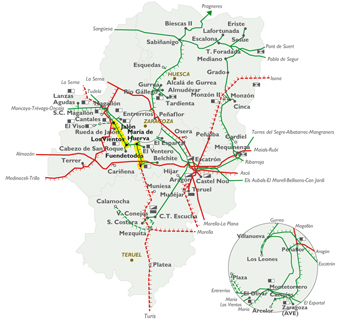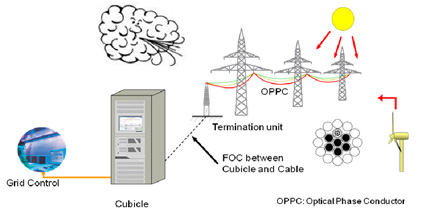For 40 years, we've been driving our country's economic and social progress. Four decades shaping Spain.
Inauguration of the Jalón-Los Vientos axis, a key infrastructure for the integration of renewable energies
The Councillor of Industry, Trade and Tourism of Aragón, Arturo Aliaga, and Carlos Collantes, the General Manager of Transmission at Red Eléctrica de España, have today inaugurated the 220 kilovolts (kV) Jalón-Los Vientos line (Zaragoza), an infrastructure that will allow, in the south of Zaragoza, the integration of renewable energies.
The Jalón-Los Vientos axis will complete, along with the future Fuendetodos-María line, the project for the closing of the 220 kV southern half-ring in Zaragoza, whose objective is to strengthen the meshing of the transmission grid so as to allow the development of wind power energy in the Ebro valley and to improve the electricity supply in the province.

The construction of the 30.4 km double circuit Jalón-Los Vientos line and the expansion of the two substations in Plasencia de Jalón and Muel, respectively, began in March 2010 and represent an investment of 19.7 million euros.
The Fuendetodos-María line, a R+D+i project backed by the Government of Aragón and the European Union
The Fuendetodos-Maria axis, which will complete the closing of the southern half-ring in Zaragoza, has been declared a project of special interest by the Government of Aragón and in addition it has been chosen by the European Twenties project for the development and implementation of new technologies that will allow a greater flexibility in the transmission grid with the aim of maximising the integration of wind power generation.
This project constitutes an innovative prototype in grid management, as it will identify the maximum transmission capacity permissible in real time by means of constantly measuring the temperature of one of the conductors.
The temperature of the transmission line cables determines its evacuation capacity and this depends directly on the wind speed that cools said line, this is the reason why those which are destined for the integration of wind power energy will be cooled more and, therefore, will have a greater transmission capacity when there is more wind and more wind power generation exists.
The new technology applied to this transmission line to be able to determine the temperature value consists of using a special conductor called OPPC (Optical Phase Conductor). This is a conventional conductor which replaces one of its aluminium filaments with a steel tube in which integrated optical fibres are housed that allow temperature measurements to be taken instantaneously and continuously.
From the María substation and by means of a DTS device (distributed temperature sensor) will shoot a laser through the optical fibre that will allow the temperature to be monitored with a precision of ± 3º C.
The innovative character of this project is that the temperature of one of the conductors along the whole line can be constantly monitored, unlike other tests carried out previously in which the measurements could only be taken at specific points, which required estimations that made the measurement unreliable.
The Fuendetodos-María line consists of a 220 kV double circuit which is 29.9 km long. It has a total budget of 20.3 million euros, of which 1.25 million will be financed by the European Union for the development of the new thermal measuring technology, and construction will begin in July this year.

Twenties Project
The European Union presented the Twenties Project in May 2010 as a pioneering initiative that brings together 26 companies and institutions of world reference in the electricity sector, with the aim of advancing in the development and implementation of new technologies that facilitate the large-scale integration of wind power generation into the European electricity system, and to fully contribute to securing the objective of the European Union for 2020 regarding energy: 20% reduction in CO2 emissions, 20% improvement in energy efficiency, and that 20% of the consumed energy is of renewable origin.
Red Eléctrica de España is the company that coordinates this initiative which is 50% financed by the European Union and is presented within the Seventh Framework Programme for research and technological development of the European Union.
The objective of the Twenties Project throughout the three years of the study is to work in six demonstrations to eliminate the barriers that hinder the incorporation of more wind power energy into the electricity system, and to present on a real scale the benefits of newly developed technologies, considered necessary for the transmission grid of the European electricity system for the 2020 horizon.












